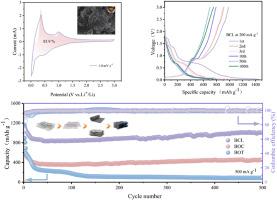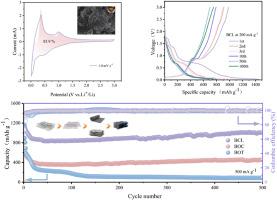Lasagne-like Bi2O3/Bi dual-carbon composites for high-capacity and long-life lithium storage
IF 9.7
2区 材料科学
Q1 MATERIALS SCIENCE, MULTIDISCIPLINARY
引用次数: 0
Abstract
Bismuth, as an alloy-type anode material for lithium-ion batteries, demonstrates high specific capacity and volumetric energy density. Nonetheless, the substantial volume expansion and capacity fade arising from prolonged charge-discharge cycling have impeded its commercial implementation. In this study, we constructed graphene, amorphous carbon layer double-coated Bi2O3/Bi composites (Gr@Bi2O3/Bi@AC) with approximate lasagna structure as anode for lithium-ion batteries. The incorporation of Bi2O3 not only facilitates lithium-ion adsorption but also mitigates volume fluctuations via conversion reactions. Multilayer graphene increases the specific surface area and enhances ion/electron transport, while its combination with amorphous carbon provides robust dual-layer protection and structural integrity. As a result, the Gr@Bi2O3/Bi@AC anode delivers a high initial coulombic efficiency (69.3 %), remarkable rate performance (466 mAh g−1 at 2000 mA g−1), and outstanding long-term cycling stability (1012.1 mAh g−1 at 500 mA g−1 over 500 cycles). This work provides a novel design to cope with the capacity decay of Bi-based materials by optimizing the dual carbon layer structure and multi-component synergistic engineering. The obtained conclusion would provide an innovative approach to design anode materials with both high capacity and stability.


宽面条状Bi2O3/Bi双碳复合材料用于高容量和长寿命锂存储
铋作为锂离子电池的合金型负极材料,具有较高的比容量和体积能量密度。然而,由于长时间的充放电循环导致的大量容量膨胀和容量衰减阻碍了其商业化实施。在这项研究中,我们构建了具有近似千层面结构的石墨烯,无定形碳层双涂层Bi2O3/Bi复合材料(Gr@Bi2O3/Bi@AC)作为锂离子电池的阳极。Bi2O3的掺入不仅有利于锂离子的吸附,而且还可以通过转化反应减轻体积波动。多层石墨烯增加了比表面积,增强了离子/电子传输,而它与无定形碳的结合提供了强大的双层保护和结构完整性。因此,Gr@Bi2O3/Bi@AC阳极提供了高初始库仑效率(69.3%),卓越的倍率性能(2000 mA g-1时466 mAh g-1),以及出色的长期循环稳定性(500次循环时500 mA g-1时1012.1 mAh g-1)。本工作通过优化双碳层结构和多组分协同工程,为应对铋基材料的容量衰减提供了一种新的设计方案。所得结论将为设计高容量、高稳定性的阳极材料提供一种创新途径。
本文章由计算机程序翻译,如有差异,请以英文原文为准。
求助全文
约1分钟内获得全文
求助全文
来源期刊

Materials Today Physics
Materials Science-General Materials Science
CiteScore
14.00
自引率
7.80%
发文量
284
审稿时长
15 days
期刊介绍:
Materials Today Physics is a multi-disciplinary journal focused on the physics of materials, encompassing both the physical properties and materials synthesis. Operating at the interface of physics and materials science, this journal covers one of the largest and most dynamic fields within physical science. The forefront research in materials physics is driving advancements in new materials, uncovering new physics, and fostering novel applications at an unprecedented pace.
 求助内容:
求助内容: 应助结果提醒方式:
应助结果提醒方式:


